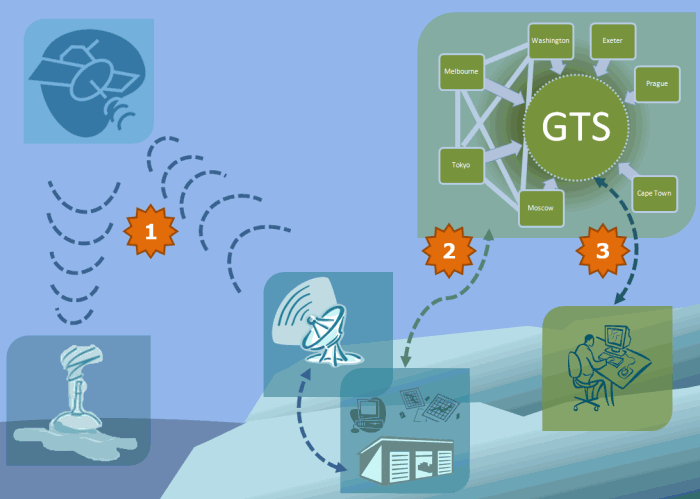Telecommunication Systems
 The telecommunications systems used for sharing buoy data in real time are divided into three distinct phases:
The telecommunications systems used for sharing buoy data in real time are divided into three distinct phases:
- From buoy to Satellite, to data processing centre.
- From data processing centre to the GTS of WMO insertion centre
- From the GTS of WMO insertion center, through the GTS to a downlink node and the data user.
Satellite Telecommunications and the Global Telecommunications System of WMO are described in detail below.
Satellite telecommunications systems
A majority of buoys used satellite telecommunications systems such as Inmarsat, ORBCOMM, Iridium or Argos to send messages.
General Information
The DBCP maintains a document reviewing the current status and recent developments in Satellite Communications Systems. Satellite Review ».
Additionally, the British Antarctic Survey has developed a Satellite communications systems buyer's guide.
Argos
The system consists of in-situ data collection platforms equipped with sensors and transmitters and the Argos instrument aboard the NOAA and EUMETSAT Polar Orbiting Environmental Satellites (POES). It provides global coverage and can be relatively inexpensive.
Argos data processing is the responsibility of CLS and CLS America and is financed through the Argos Joint Tarif Agreement. The Argos system provides a user friendly online system to access data and platform information.
http://www.argos-system.org/.
For further detail see:
Iridium
Iridium telecommunications offers several different types of services for data sharing depend on requirements. It provides global coverage and can be relatively inexpensive. The DBCP has to-date used the Short Burst Data mode for drifting buoys. The Iridium pilot project is testing the use of iridium SBD Modem (9601) to reduce delays in receiving drifter data in remote areas. Iridium allows a large amount of data to be delivered very quickly. More Information from the Iridium web site.
Information about data formats in use, by the DBCP, for Argos and Iridium is available under Data Management and Flow
Other systems in use
Many moored buoys use one of the following satellite telecommunications systems:
GTS of WMO
The coordinated global system of telecommunication facilities and arrangements for the rapid collection, exchange and distribution of observations and processed information within the framework of the World Weather Watch. from WMO No 49 Technical Regulations.
What is the GTS? Read more »
Inserting data
Data is inserted onto the GTS by operational centers in real time, in the form of GTS reports which are embedded within GTS bulletins identified by GTS bulletin headers to make sure they reach the right operational centres. A number defined by WMO identifies a platform within the messages. Rules for allocating WMO Identifiers are here »
Accessing data
Users can then access data via national meteorological centres. Information about accessing data is available on under data access.
More information about the GTS is available on the data sharing page.
Delays
The DBCP strives to improve data throughput from all buoys and reduce the delays experienced between a measurement being taken and the reception of the data by forecasters and modeling centers.
The biggest source of delays is between the buoy and the satellite and then between the satellite and the ground station or data processing center. As bandwidth on connections between GTS centers is now usually very good that is not a significant source of delay. The improved satellite telecommunications available today have reduced the delays in the system, in the last 20 years.
This is an area that the DBCP works hard to improve across the global ocean.
A 'GTS delays' map is produced to show average delays for the buoy network each month.



